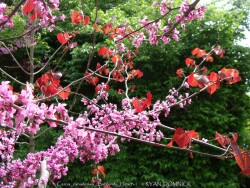
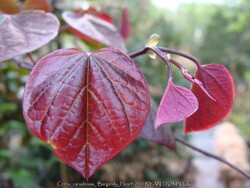
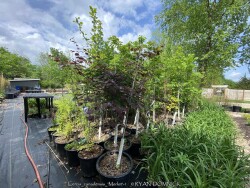
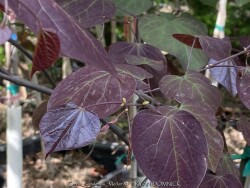
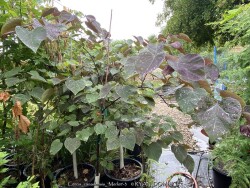
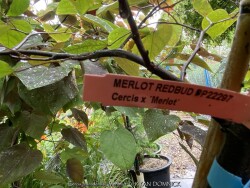
Plant Min Zone: 5a
Plant Max Zone: 9a
Sunlight: Full Sun, Part Sun, Shade
Water / Rainfall: Low, Average, High
Soil Quality: Poor, Average
Bloom Season: Spring
Flower Color: Magenta
Berry / Fruit Color: Green, Black
Spring Foliage Color: Maroon, Reddish Purple
Summer Foliage Color: Maroon, Reddish Purple
Fall Foliage Color: Maroon, Reddish Purple
Evergreen Foliage: No
Winter Interest: No
Scented Flowers: No
Drought Tolerance: Medium, High
Wet-Feet Tolerance: Low
Humidity Tolerance: Medium, High
Wind Tolerance: Medium
Poor Soil Tolerance: Clay Soils, Rocky Soils, Sandy Soils, Alkaline Soils (high PH)
Height: 10' - 15'
Width: 10' - 15'
Growth Rate: Medium
Service Life: Tree: Service life varies
Maintenance Need: Low
Spreading Potential: N.A.
Yearly Trimming Tips: Selectively Prune into Small Tree Shape over Period of Many Years.
Plant Grouping Size: Specimen Planting of 1-3, Small Grouping of 3-5
Best Side of House: South Exposure, West Exposure, East Exposure
Extreme Planting Locations: None
Ornamental Features: Multiple Seasons of Interest, Long Blooming Season, Exceptional / Colorful Foliage
Special Landscape Uses: Clean Street Tree
Possible Pest Problems: Occasional Problems, Disease, Insects, Deer, Rabbits
Plant Limitations: Susceptible to Late Spring Frosts, May get Wind Damage / Weak Wood
Shippable in 2026: YES
Cercis canadensis Burgundy Hearts® is an improved reddish purple-leaf variety developed by Greenleaf Nurseries in Oklahoma. Burgundy Hearts more drought and heat tolerant. Pinkish-lavender April flowers bloom for about a month before leaves appear. It has a more or less rounded form, wider than it is tall. This small deciduous tree is known for its heart-shaped leaves that hold their dark color longer in the summer, taking on reddish wine tones towards the fall. Many of the problems with the regular species redbud tree are not an issue with this improved cultivar. It is to be expected however that all Redbuds have a relatively short lifespan of 20-40 years but even so, are worth planting for its beautiful flowers. It is not weak wooded and makes a nice hot non-sparking firewood. The short life span is not due to breakage so much as it is to the tree's susceptibility to heart-rot especially when branch crotches form and get older. Other problems include canker, verticillium wilt and root rot. Most redbud varieties thrive in full sun to partial shade. They will tolerate full shade but become elongated and thin as they reach for the sun. Redbuds do well in most soil types but adequate drainage is a must; it can tolerate dry shade of Eastern Kansas forests receiving at least 35" of rainfall per year. The species is a native from southern Canada to Florida, east to Kansas. The regular species also has the potential to self seed in your yard but not Burgundy Hearts. As a dwarf tree, use 'Merlot' as a specimen or part of a group. It reaches about 20 to 30 feet high and wide in full sun. Reddish leaf color emerges in the spring and is maintained all summer long if in mostly full sun. The color of older purple redbuds (like Forest Pansy) fades to dark green as the summer heat intensifies.